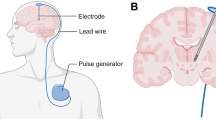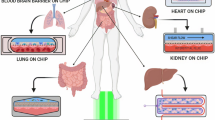Abstract
Microinfusions of drugs directly into the central nervous system of awake animals represent a widely used means of unravelling brain functions related to behaviour. However, current approaches generally use tethered liquid infusion systems and a syringe pump to deliver drugs into the brain, which often interfere with behaviour. We address this shortfall with a miniaturised electronically-controlled drug delivery system (20 × 17.5 × 5 mm3) designed to be skull-mounted in rats. The device features a micropump connected to two 8-mm-long silicon microprobes with a cross section of 250 × 250 μm2 and integrated fluid microchannels. Using an external electronic control unit, the device allows infusion of 16 metered doses (0.25 μL each, 8 per silicon shaft). Each dosage requires 3.375 Ws of electrical power making the device additionally compatible with state-of-the-art wireless headstages. A dosage precision of 0.25 ± 0.01 μL was determined in vitro before in vivo tests were carried out in awake rats. No passive leakage from the loaded devices into the brain could be detected using methylene blue dye. Finally, the device was used to investigate the effects of the NMDA-receptor antagonist 3-((R)-2-Carboxypiperazin-4-yl)-propyl-1-phosphonic acid, (R)-CPP, administered directly into the prefrontal cortex of rats during performance on a task to assess visual attention and impulsivity. In agreement with previous findings using conventional tethered infusion systems, acute (R)-CPP administration produced a marked increase in impulsivity.








Similar content being viewed by others
References
Akzo Nobel, Eine technische Präsentation der Expancel® Mikrosphären, Technische Information Nr. 40 (2006)
A. Bari, J.W. Dalley, T.W. Robbins, The application of the 5-choice serial reaction time task for the assessment of visual attentional processes and impulse control in rats. Nat. Protoc. 3(5), 759–767 (2008)
A. Bonfanti, G. Zambra, G. Baranauskas, G.N. Angotzi, E. Maggiolini, M. Semprini, A. Vato, L. Fadiga, A.S. Spinelli, A.L. Lacaita, A wireless microsystem with digital data compression for neural spike recording. Microelectron. Eng. 88(8), 1672–1675 (2011)
M.A. Bozarth, R.A. Wise, Electrolytic microinfusion transducer system: an alternative method of intracranial drug application. J. Neurosci. Methods 2(3), 273–275 (1980)
M. Carli, M. Baviera, R.W. Invernizzi, C. Balducci, Dissociable contribution of 5-HT1A and 5-HT2A receptors in the medial prefrontal cortex to different aspects of executive control such as impulsivity and compulsive perseveration in rats. Neuropsychopharmacology 31(4), 757–767 (2006)
J. Chen, K.D. Wise, J.F. Hetke, S.C. Bledsoe Jr., A multichannel neural probe for selective chemical delivery at the cellular level. IEEE Trans. Biomed. Eng. 44(8), 760–769 (1997)
H.E. Criswell, A simple chronic microinjection system for use with chemitrodes. Pharmacol. Biochem. Behav. 6(2), 237–238 (1977)
H. Domininghaus, P. Elsner, P. Eyerer, T. Hirth, Kunststoffe: Eigenschaften und Anwendungen, 7th edn. (Springer, Berlin, 2008)
D. Fan, D. Rich, T. Holtzman, P. Ruther, J.W. Dalley, A. Lopez, M.A. Rossi, J.W. Barter, D. Salas-Meza, S. Herwik, T. Holzhammer, J. Morizio, H.H. Yin, A wireless multi-channel recording system for freely behaving mice and rats. PLoS One 6(7), e22033 (2011)
O. Frey, T. Holtzman, R.M. McNamara, D.E.H. Theobald, P.D. van der Wal, N.F. de Rooij, J.W. Dalley, M. Koudelka-Hep, Enzyme-based choline and l-glutamate biosensor electrodes on silicon microprobe arrays. Biosens. Bioelectron. 26(2), 477–484 (2010)
P. Griss, H. Andersson, G. Stemme, Expandable microspheres for the handling of liquids. Lab Chip 2(2), 117–120 (2002)
M. HajjHassan, V. Chodavarapu, S. Musallam, NeuroMEMS: neural probe microtechnologies. Sens. 8(10), 6704–6726 (2008)
A.C. Hoogerwerf, K.D. Wise, A three-dimensional microelectrode array for chronic neural recording. IEEE Trans. Biomed. Eng. 41(12), 1136–1146 (1994)
S. Ikemoto, L.G. Sharpe, A head-attachable device for injecting nanoliter volumes of drug solutions into brain sites of freely moving rats. J. Neurosci. Methods 110(1–2), 135–140 (2001)
M.D. Johnson, R.K. Franklin, M.D. Gibson, R.B. Brown, D.R. Kipke, Implantable microelectrode arrays for simultaneous electrophysiological and neurochemical recordings. J. Neurosci. Methods 174(1), 62–70 (2008)
D.R. Kipke, W. Shain, G. Buzsáki, E. Fetz, J.M. Henderson, J.F. Hetke, G. Schalk, Advanced neurotechnologies for chronic neural interfaces: new horizons and clinical opportunities. J. Neurosci. 28(46), 11830–11838 (2008)
G. Lacey, Microelectrophoresis and Pressure Ejection Methods, in Neuroscience Methods: A Guide for Advanced Students, ed. by R. Martin (Harwood Academic Publishers, Amsterdam, 1997), pp. 80–84. Chap. 12
P.M. Lalley, Microiontophoresis and Pressure Ejection, in Modern Techniques in Neuroscience Research, ed. by U. Windhorst, H. Johansson (Springer, Berlin, 1999), pp. 193–212. Chap. 7
P.S. Motta, J.W. Judy, Multielectrode microprobes for deep-brain stimulation fabricated with a customizable 3-D electroplating process. IEEE Trans. Biomed. Eng. 52(5), 923–933 (2005)
E.R. Murphy, J.W. Dalley, T.W. Robbins, Local glutamate receptor antagonism in the rat prefrontal cortex disrupts response inhibition in a visuospatial attentional task. Psychopharmacol. (Heidelberg, Ger.) 179(1), 99–107 (2005)
S. Musa, M. Welkenhuysen, R. Huys, W. Eberle, K. Kuyck, C. Bartic, B. Nuttin, G. Borghs, Planar 2D-Array Neural Probe for Deep Brain Stimulation and Recording (DBSR), in Proc. 4th Eur. Conf. of the IFMBE, IFMBE Proceedings, vol. 22 (Springer, Berlin, 2009), pp. 2421–2425
H.P. Neves, G.A. Orban, M. Koudelka-Hep, T. Stieglitz, P. Ruther, Development of modular multifunctional probe arrays for cerebral applications, in Proc. 3rd Int. IEEE EMBS Conf. on Neural Eng., pp. 104–109 (2007)
P. Norlin, M. Kindlundh, A. Mouroux, K. Yoshida, U.G. Hofmann, A 32-site neural recording probe fabricated by DRIE of SOI substrates. J. Micromech. Microeng. 12(4), 414–419 (2002)
T.W. Robbins, The 5-choice serial reaction time task: behavioural pharmacology and functional neurochemistry. Psychopharmacol. (Heidelberg, Ger.) 163(3–4), 362–380 (2002)
N. Roxhed, S. Rydholm, B. Samel, W. van der Wijngaart, P. Griss, G. Stemme, A compact, low-cost microliter-range liquid dispenser based on expandable microspheres. J. Micromech. Microeng. 16(12), 2740–2746 (2006)
S. Royer, B.V. Zemelman, M. Barbic, A. Losonczy, G. Buzsáki, J.C. Magee, Multi-array silicon probes with integrated optical fibers: light-assisted perturbation and recording of local neural circuits in the behaving animal. Eur. J. Neurosci. 31(12), 2279–2291 (2010)
P. Ruther, A. Aarts, O. Frey, S. Herwik, S. Kisban, K. Seidl, S. Spieth, A. Schumacher, M. Koudelka-Hep, O. Paul, T. Stieglitz, R. Zengerle, H. Neves, The NeuroProbes project – Multifunctional probe arrays for neural recording and stimulation. Biomed. Techn. 53(Suppl. 1), 238–240 (2008)
P. Ruther, S. Herwik, S. Kisban, K. Seidl, O. Paul, Recent progress in neural probes using silicon MEMS technology. IEEJ Trans. Electr. Electron. Eng. 5(5), 505–515 (2010)
B. Samel, P. Griss, G. Stemme, A thermally responsive PDMS composite and its microfluidic applications. J. Microelectromech. Syst. 16(1), 50–57 (2007)
K. Seidl, S. Spieth, S. Herwik, J. Steigert, R. Zengerle, O. Paul, P. Ruther, In-plane silicon probes for simultaneous neural recording and drug delivery. J. Micromech. Microeng. 20(10), 105006 (11pp) (2010).
S. Spieth, A. Schumacher, K. Seidl, K. Hiltmann, S. Haeberle, R. McNamara, J.W. Dalley, S.A. Edgley, P. Ruther, R. Zengerle, Robust microprobe systems for simultaneous neural recording and drug delivery, in Proc. 4th Eur. Conf. of the IFMBE, IFMBE Proceedings, vol. 22 (Springer, Berlin, 2009), pp. 2426–2430
S. Spieth, A. Schumacher, S. Messner, T. Holtzman, P.D. Rich, J.W. Dalley, R. Zengerle, A miniaturized on-demand drug delivery system for neural research, in Proc. 6th Int. Conf. on Microtechn. in Med. and Biol., pp. 62–63 (2011)
S. Spieth, A. Schumacher, S. Messner, R. Zengerle, The NeuroMedicator - A micropump integrated with silicon microprobes for drug delivery in neural research. J. Micromech. Microeng., in press (2012)
T.A. Szuts, V. Fadeyev, S. Kachiguine, A. Sher, M.V. Grivich, M. Agrochão, P. Hottowy, W. Dabrowski, E.V. Lubenov, A.G. Siapas, N. Uchida, A.M. Litke, M. Meister, A wireless multi-channel neural amplifier for freely moving animals. Nat. Neurosci. 14(2), 263–269 (2011)
K.D. Wise, A.M. Sodagar, Y. Yao, M.N. Gulari, G.E. Perlin, K. Najafi, Microelectrodes, microelectronics, and implantable neural microsystems. Proc. IEEE 96(7), 1184–1202 (2008)
A.N. Zorzos, E.S. Boyden, C.G. Fonstad, Multiwaveguide implantable probe for light delivery to sets of distributed brain targets. Opt. Lett. 35(24), 4133–4135 (2010)
Acknowledgments
This work was performed in the frame of the Information Society Technologies (IST) Integrated Project Neuro-Probes of the 6th Framework Program (FP6) of the European Commission (Project number IST-027017). The authors gratefully acknowledge funding support by the Wellcome Trust and MRC in the United Kingdom through support of the Behavioural and Clinical Neuroscience Institute (BCNI) at Cambridge University. We also acknowledge support from Karsten Seidl, Patrick Ruther, and the cleanroom facility of IMTEK, University of Freiburg, as well as the support from the cleanroom and the machine shop facilities at HSG-IMIT. The authors would like to thank Joachim Leicht, Bernd Ehrbrecht, Jürgen Merz, and Alexander Fabricius (all HSG-IMIT) for conception, assembly, and programming of the electronic control unit. Furthermore, the authors would like to thank Björn Samel and Göran Stemme of Royal Institute of Technology Stockholm for useful discussions and insights. The provision of microspheres from Expancel, Sundsvall, Sweden, TPE membranes from KRAIBURG TPE GmbH & Co. KG, Waldkraiburg, Germany, and COP plates from Zeon Corporation, Tokyo, Japan, is gratefully acknowledged.
Author information
Authors and Affiliations
Corresponding author
Rights and permissions
About this article
Cite this article
Spieth, S., Schumacher, A., Holtzman, T. et al. An intra-cerebral drug delivery system for freely moving animals. Biomed Microdevices 14, 799–809 (2012). https://doi.org/10.1007/s10544-012-9659-2
Published:
Issue Date:
DOI: https://doi.org/10.1007/s10544-012-9659-2




